As we’re moving towards the end of 2019, employee onboarding still seems to be in need of some refinements.
According to Gallup1, a whopping 88% of employees suggest that their companies don’t provide a good onboarding program. This finding shouldn’t surprise anyone if you think that 58% of organizations focus their onboarding program on processes and paperwork2.
It’s high time companies invested in a strong onboarding process. According to Glassdoor3, by doing so, new hire retention improves by 82% and productivity by more than 70%.
In October 2018, our TalentLMS’ onboarding survey revealed what onboarding new hires get, how they get it, and what they think about it. As it turned out, only 39% of U.S. employees receive company-culture training during onboarding. Ditto with soft skills training. When asked if the onboarding training they did receive helped lessen their newcomer anxiety, the same employees weren’t exactly complimentary.
65% of respondents indicated that their employee onboarding helped them “somewhat” or “not at all”.
It seems that onboarding efforts aren’t aligning with the challenges that new hires face.
Why should you care?
According to Josh Bersin of Deloitte4, the cost of losing an employee is estimated to be at least two times their salary. Scarier than that? A different study by Equinox (and reported by Fast Company5) found that more than 40% of staff turnover occurs in the first month of employment. At the same time, Brandon Hall’s Evolution of Onboarding Study6 found that the highest rate of turnover occurred within the first six months.
This is exactly why every business, big or small, must invest in an employee onboarding training program that works.
In September 2018, in partnership with Dr. Allison M. Ellis, Ph.D., Assistant Professor of Management and Human Resources at the California Polytechnic State University, we ran a survey to assess employee onboarding experiences.
Dr. Ellis defines onboarding as, “the process of assisting new hires in gaining a functional understanding of the skills and tasks required in their new role, helping them to develop new relationships with others in the workplace, and facilitating an understanding of the company culture and goals.”
But what makes a staff onboarding program effective? And how can you deliver the best onboarding experience for new hires?
Drawing on data from our own research, we’ll explore the state of onboarding in the U.S., reveal the top concerns newcomers have, and show how you can start addressing their concerns.
In particular, you’ll learn:
- The state of employee onboarding
- How new hires feel about onboarding
- Three top factors that improve onboarding satisfaction
- Five best employee onboarding practices revealed in our research
The Current State of Employee Onboarding
First things first. To determine how you can create the best onboarding experience for your new hires, you first need to know what the general landscape looks like. Below, some details about how companies are delivering and organizing onboarding training.
Breakdown of onboarding by delivery method
We discovered that 27% of respondents were onboarded exclusively using online onboarding methods. Forty percent indicated that their organizations used traditional, offline methods. And, the remaining 33% were onboarded with a blended learning approach, which refers to the rising trend of combining online and offline methods.
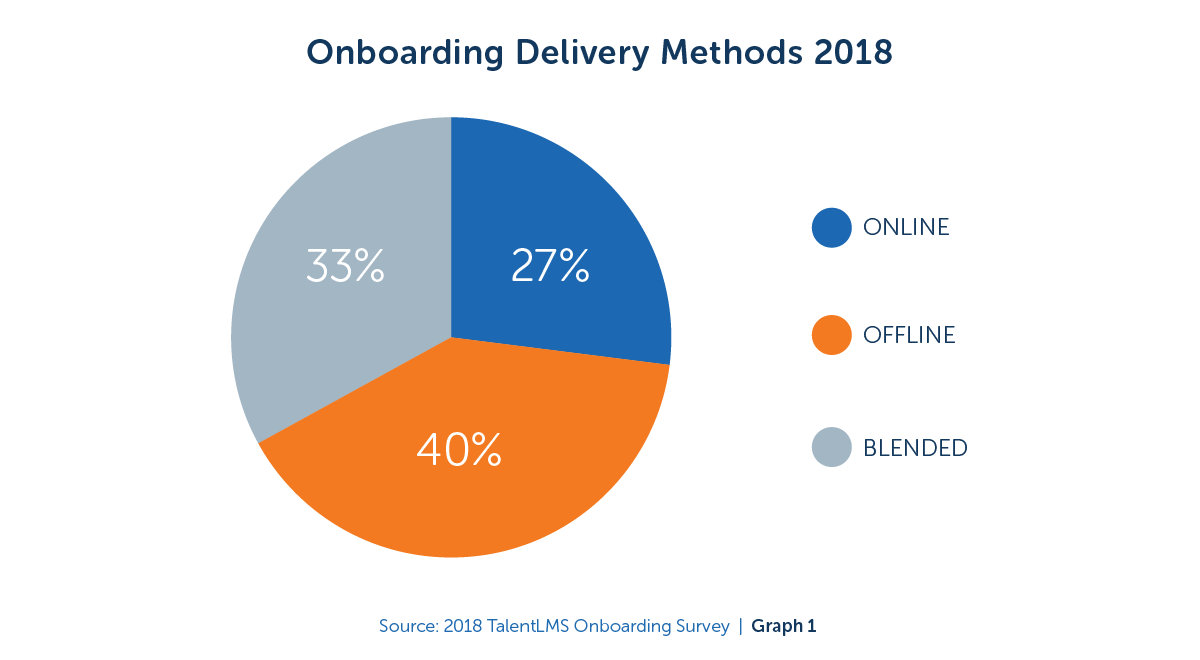
Online methods include using a learning platform, instructor-led training through video or conference, through email or a shared drive and over mobile phones.
Offline methods include face-to-face and/or self-instructed paper-based onboarding.
In terms of company size, there was a clear difference in delivery methods. It appears that smaller companies are more likely to use offline methods. As company size grows, it’s more likely for employers to start using online methods.
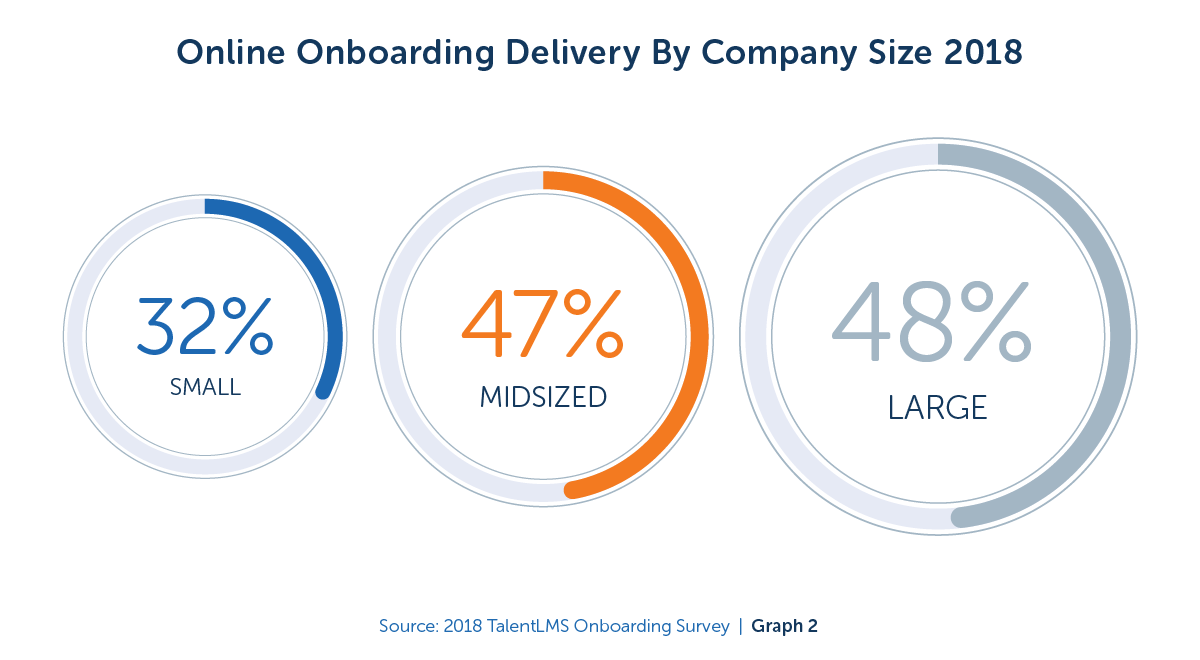
The Formats That Dominate New-Hire Onboarding
Fifty-four percent of our respondents said they had some type of hands-on training during onboarding. Shockingly, 35% said their onboarding training was delivered with paper-based manuals (and they didn’t even have to jump into a Delorean and travel back to the 80s for that.)
Here’s a detailed list of all formats used for new hire training.
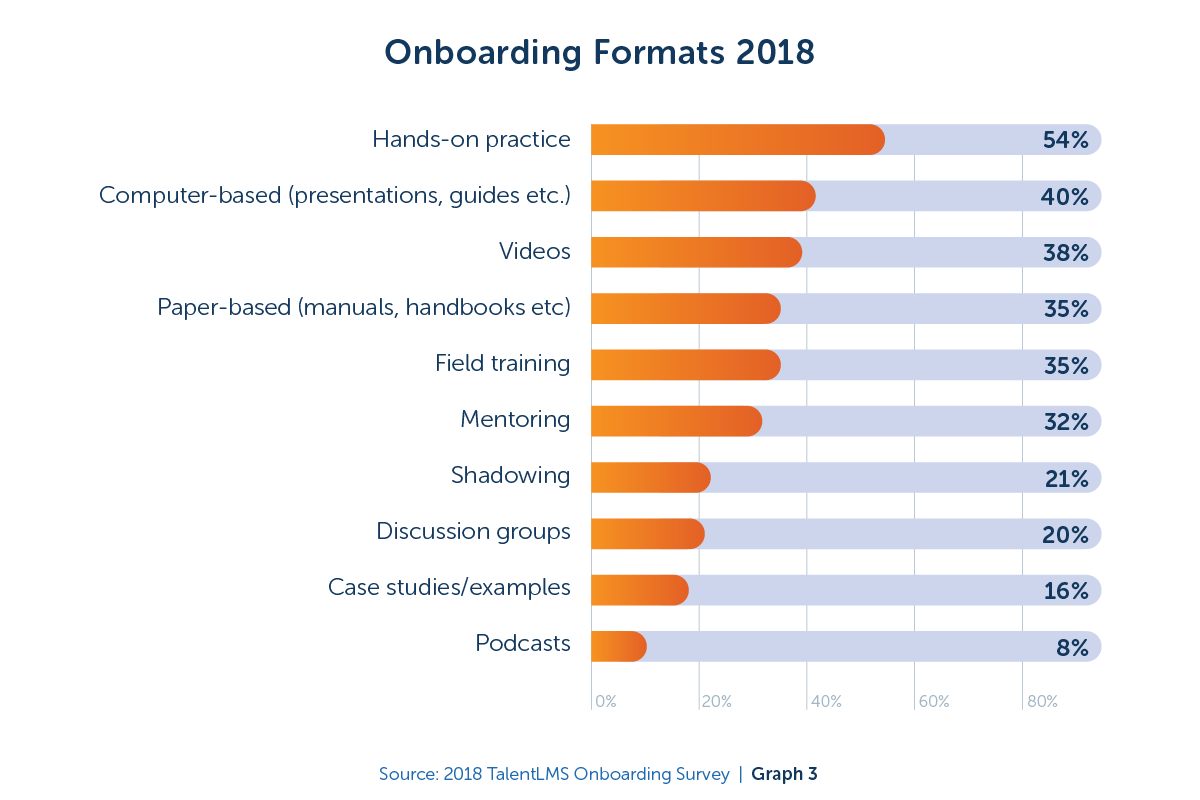
What Are Onboarding Programs Made Up Of?
Overall, it seems that mandatory compliance training (health & safety, fire awareness, etc.) makes up the majority of onboarding programs with 53% of employees receiving it. As you can see in Graph 4, employers seem to be focusing on practical and on-the-job skills.
In fact, only a quarter of respondents indicated they received culture-onboarding. Soft skill training and product training also seem to be getting the least amount of attention.

Duration of onboarding
The most common duration for training new employees is up to one week. Now, we didn’t account for role type or level of responsibility, so it’s unclear if this is enough training. Arguably, one week does not feel like enough time for an “outsider” to smoothly become a productive part of a team. In fact, research suggests that the socialization process can take up to a year7.

That’s the anatomy of U.S. onboarding today. How does your onboarding program compare?
How do new hires feel about onboarding?
While most HR managers are in agreement about the importance of onboarding training, other stakeholders in your organization might not be. That’s why we asked our respondents how they felt about the onboarding at their current job. It seems that they agree too – onboarding has a positive impact both on the culture of an organization and its productivity.
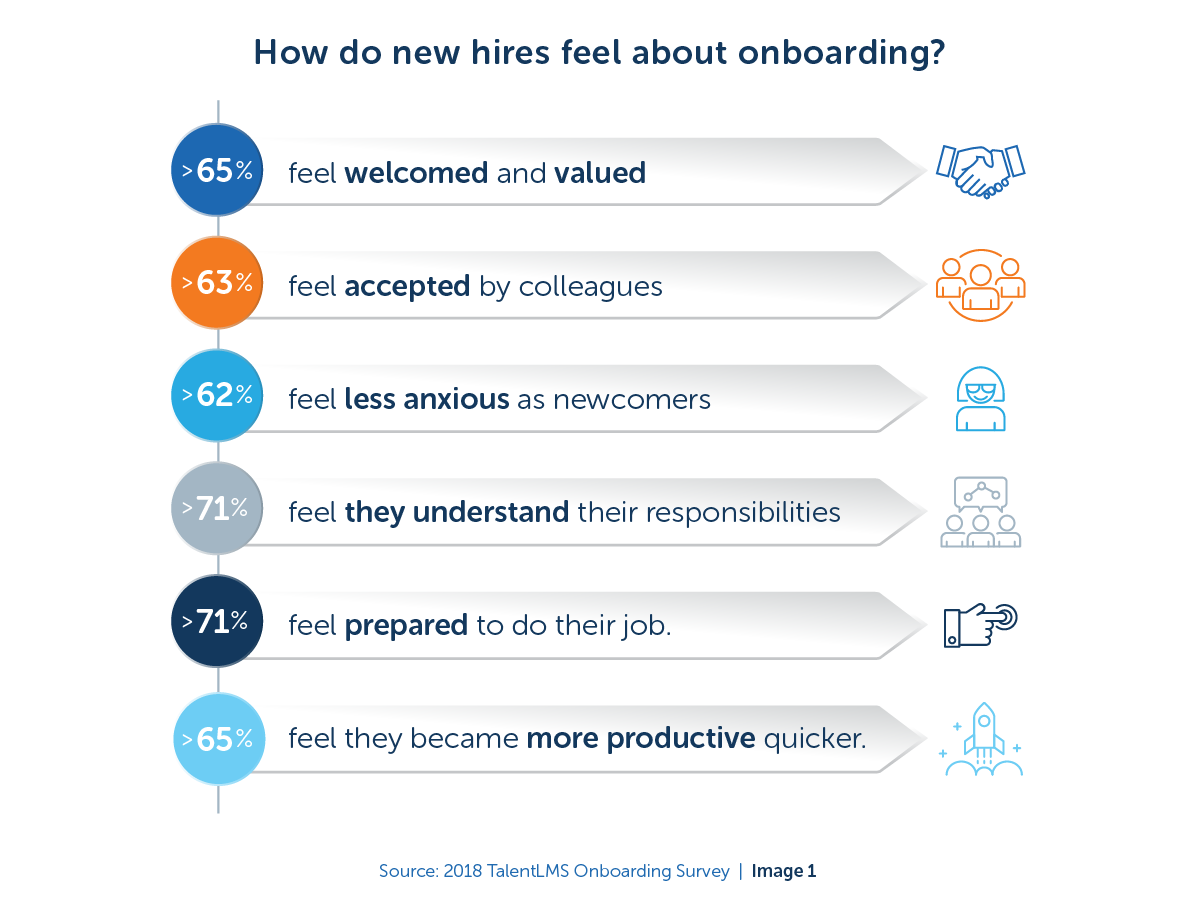
When we asked respondents to rate their satisfaction with their overall onboarding, the results, at first glance, were encouraging.
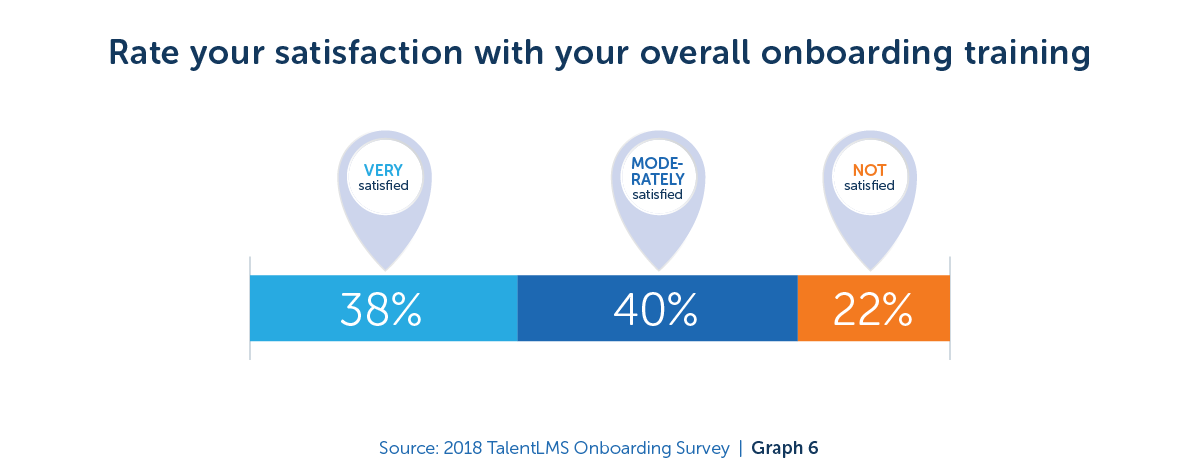
The numbers in Graph 6 are respectable. They’re solid. But (you knew a but was coming, didn’t you?) there’s lots of room for improvement.
Note: We ran a correlation between satisfaction and company size and found no relationship between the two. This could mean many things, like satisfaction with onboarding isn’t a function of resources (like many big companies have) or a matter of closeness (like small companies have).
There was, however, a relationship, between satisfaction and delivery type.
The employees in our research indicated they were more satisfied with their onboarding process when it was delivered via a combination of online and offline delivery methods.
This means that blended learning might be the perfect fit for onboarding new employees.
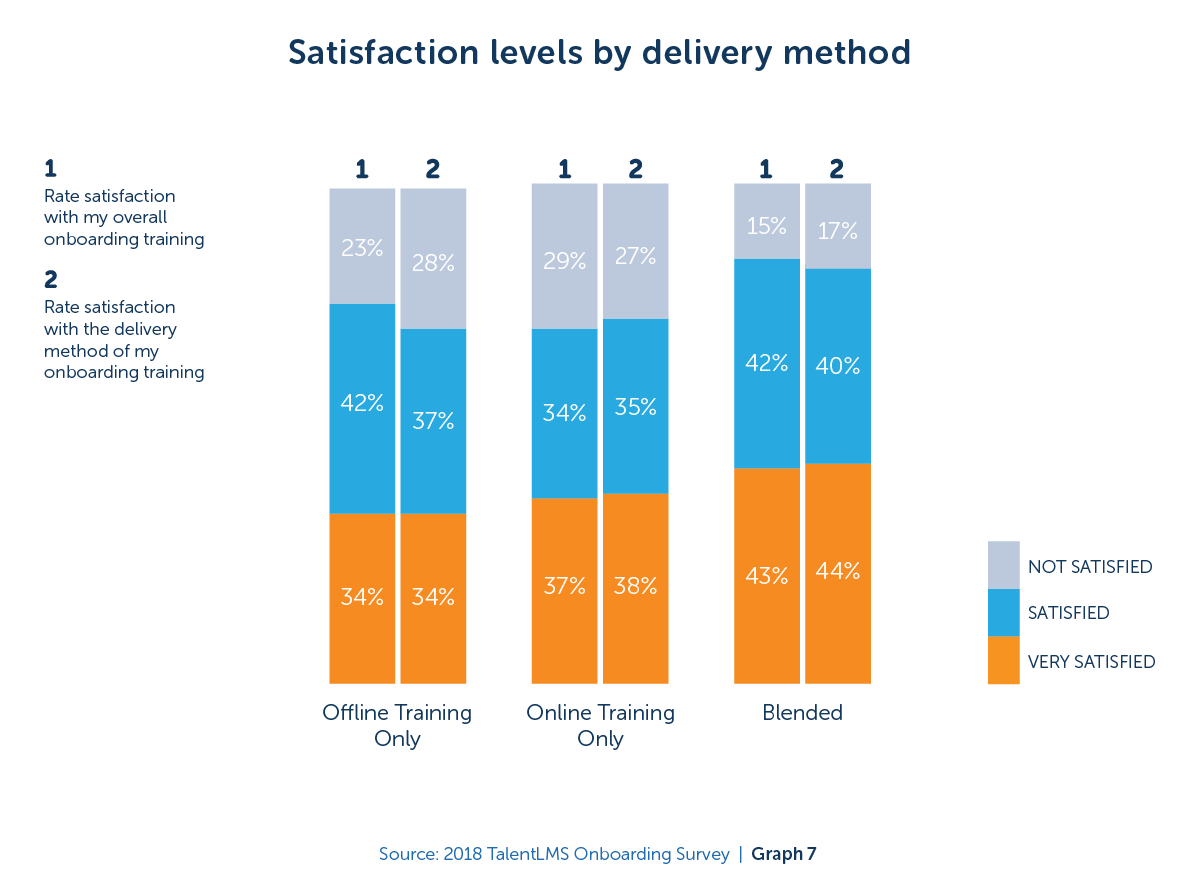
Top concerns about staff onboarding
We asked our respondents to rank the challenges they faced during their onboarding process. The list was made up of 3 skill-related concerns and 4 company culture-related concerns.
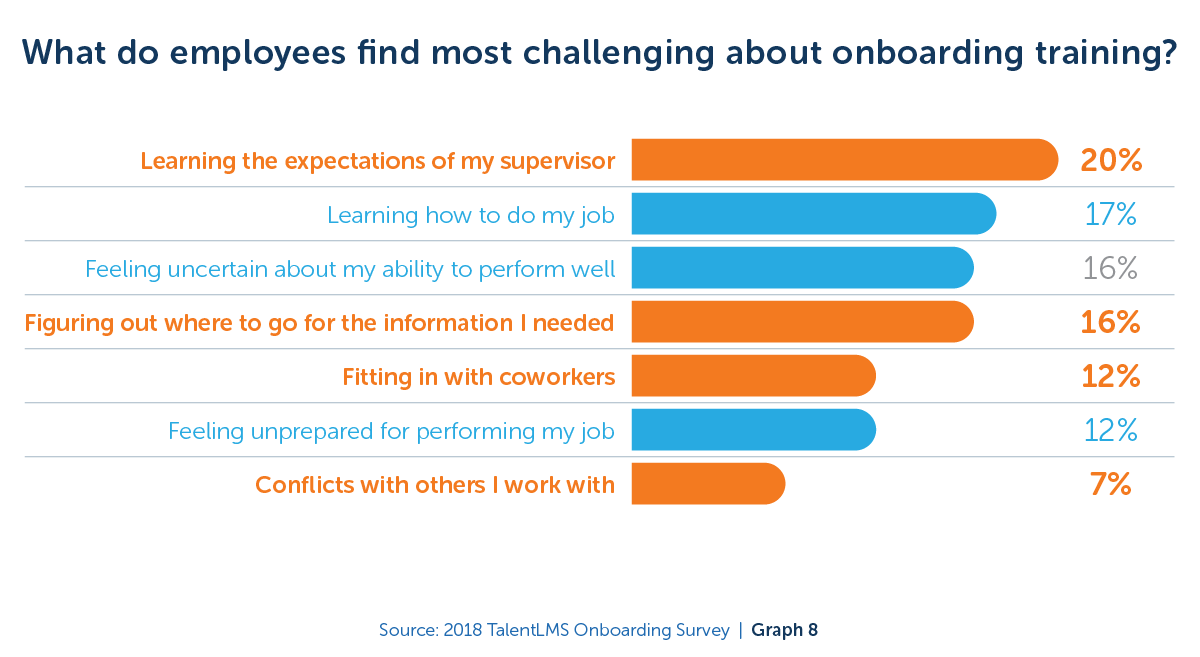
The data shows that the number one concern employees have about their onboarding experience is understanding the expectations of their supervisor (a culture-related concern). The number two concern is learning how to do their job (a skill-related concern).
Is onboarding addressing new hires’ concerns?
Only a third of respondents indicated that their onboarding training provided the resources and tools required to help them with their concerns.
The other 65% of respondents indicated that their employee onboarding process only helped them “somewhat” or “not at all”.
This paints a picture that onboarding efforts aren’t aligning with the challenges that new hires face. This was true for both skill-related concerns and culture-related concerns.
In fact, when we compared the relationship between concern type and respondents who indicated their onboarding helped to a great extent, there was no difference.
This suggests that both skill-related training and company culture-related training are equally important in addressing the concerns of new hires.
And yet, as you recall from Graph 4, 61% of our respondents’ employee onboarding experience did not include any training on company culture, mission, or value.
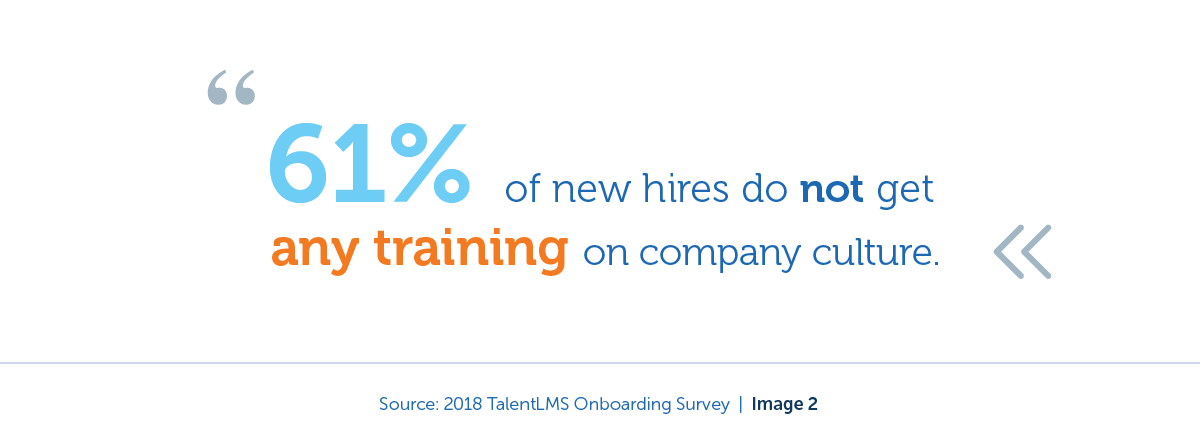
This is startling because back in 2014 a Collegefeed poll8 found that millennials rank “people and culture fit” as the most important thing they look for in future employers.
Combine these findings with Gallup’s State of the American Workforce (2016)9 that found only a third of U.S. employees are engaged with work, and there’s one conclusion.
Businesses aren’t supporting their staff in effective ways, they’re ignoring company culture almost entirely and they’re ultimately leaving money on the table.
What improves onboarding training satisfaction
Our academic partner, Dr. Ellis, who has been studying onboarding for years, has found that managers play an integral role10 in the employee onboarding process. It is managers who make a difference as to how welcome and connected to an organization newcomers feel. So, one question we wanted to answer was whether the act of simply meeting a supervisor on day one had an impact on a new hire’s onboarding experience.
Spoiler alert: it does.
Meeting a supervisor makes a difference
According to our study, 15% of respondents did not meet their supervisor on the first day.
And those who didn’t, had a lower rate of overall onboarding satisfaction, and an even lower rate of job satisfaction.
In fact, simply meeting a supervisor on day one had a major impact on all levels of satisfaction.
For example, the overall onboarding experience of employees who did not meet their supervisors on the first day scored a satisfaction rate of 20%. For those welcomed by their supervisors, the number doubled to 41%.
BambooHR’s findings also agree that supervisory roles have an impact on onboarding. When they asked new hires why they left a job in the first 6 months, one of the most popular responses was “They felt their boss was a jerk”.
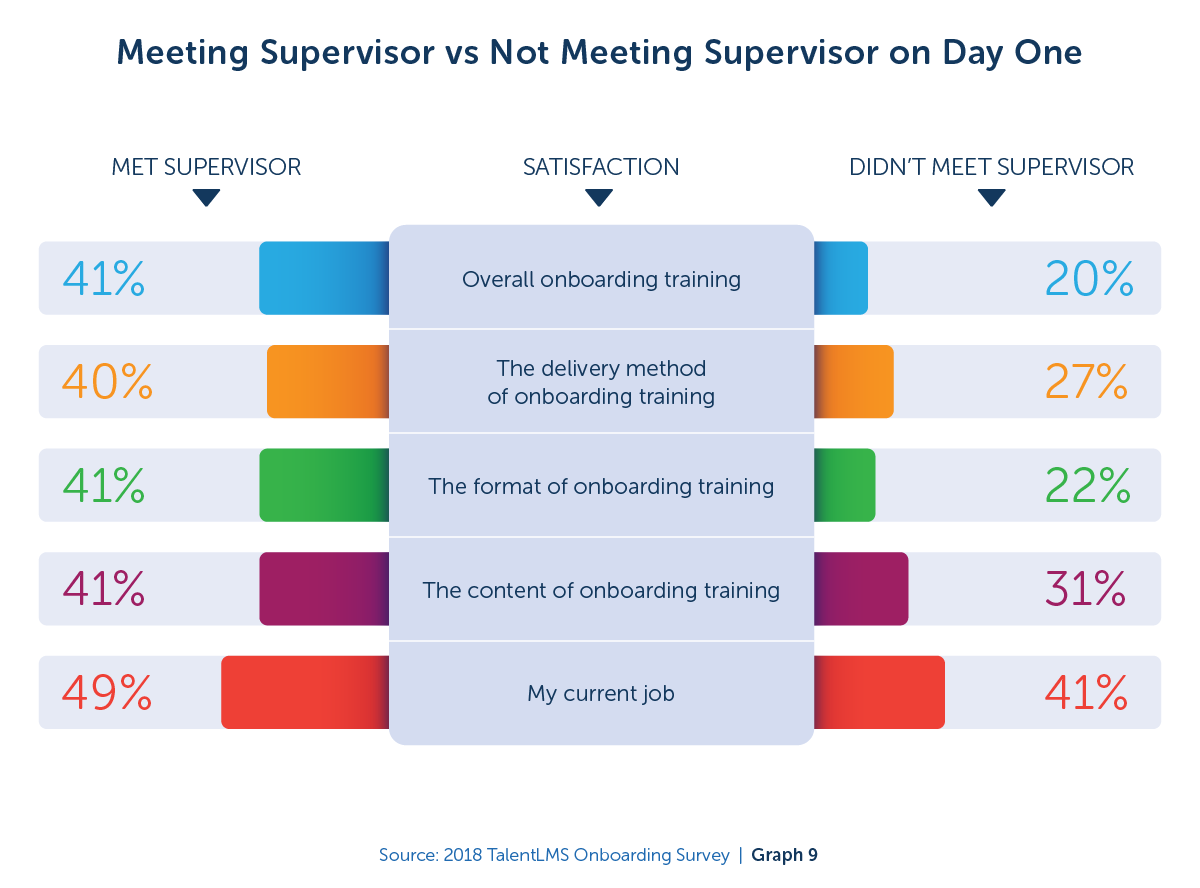
Age matters
As you recall, our respondents ranked “understanding the needs of my supervisor” as their top concern as a new hire. When we peeled back the layers in our data though, we found that age can influence those concerns.
Younger employees between 18 – 24 years old, who we assume are also most likely to be inexperienced, are more concerned about the mechanics of doing their job, while older employees between 24 – 53 years old, who are in the prime of their working lives, indicate they are most concerned about the expectations of their supervisor.
This might mean that older (or more experienced) new hires are more concerned about company culture during onboarding and less about learning how to do their jobs.
Need for connectedness
When we combine our findings, a clearer picture is created about onboarding. Employees want to belong in a workspace where they share the same values, goals, and vision. When they find it? They’re happy and more likely to stay for the long haul. New hires, from day one, express the need to connect with real human beings (especially their supervisor) as well as connect with the organization as a whole. They’re people, after all. Not machines.

Five best practices for successful onboarding training
From the results of our research, we have a few recommendations for you to use when you’re planning your employee onboarding. Whether you’re creating a program from scratch or already have a process in place, these five tips might be exactly what you need to create a memorable and unforgettable onboarding experience.
Tip 1
Tailor your new hire orientation process to the individual’s age and/or experience level. Younger hires may need extra training, while older hires may need less job training and just a clear list of responsibilities and expectations.
Tip 2
One factor that seems to improve onboarding is its duration. In our survey, the longer onboarding lasted, the more employees felt prepared to overcome the challenges of being new. Try extending your onboarding process with more useful content. (Don’t forget cultural-onboarding and soft skill training too!)
Tip 3
Every method has its place. Face-to-face interactions are important, but it seems that using onboarding tools and technology such as onboarding training software is important too. A blended learning approach is key to creating an overall successful onboarding experience. Use both.
Tip 4
Absolutely, no-excuses, have your new hires meet their supervisor on day one, you guys. Do it.
Tip 5
Do not avoid “culture” as part of your onboarding program. You don’t need to go to the lengths that Zappos does (five-week course on culture and values)8. But, if you’re looking to retain your best talent and create the best onboarding experience for new hires, definitely add a culture module.
About our survey:
Our findings come from a study we ran in September 2018 with Dr. Allison M. Ellis, Ph.D., Assistant Professor of Management and Human Resources at the California Polytechnic State University. We asked respondents one open-ended question and 17 close-ended questions.
Of the 399 respondents in our survey:
- All are employed for wages
- All are at their current job for no more than a year
- All have experienced some form of onboarding at their current job
- 166 are in supervisory roles (or 41% of the sample)
- All range in age from 18 – 71, with a median of 33 years old
- All are working in a range of industries with a concentration in retail (11%), education (11%) and health care and social assistance (16%)
Sources:
1. “State of the American Workplace”, Gallup, https://www.gallup.com/workplace/238085/state-american-workplace-report-2017.aspx
2. Filipkowski, Jenna. “Talent Pulse”, Human Capital Institute, last modified June 22, 2016
http://www.hci.org/files/field_content_file/2016%20Talent%20Pulse%20TA.pdf
3. Laurano, Madeline. “The True Cost of Bad Hire”, Glassdoor, last modified August 2015
https://b2b-assets.glassdoor.com/the-true-cost-of-a-bad-hire.pdf
4. Bersin, Josh. “Employee Retention Now a Big Issue: Why the Tide has Turned”, LinkedIn, last modified August 16, 2013
https://www.linkedin.com/pulse/20130816200159-131079-employee-retention-now-a-big-issue-why-the-tide-has-turned/
5. Vozza, Stephanie. “What To Do During Your Employees’ First Week To Avoid Losing Them”, Fast Company, last modified September 5, 2016
https://www.fastcompany.com/3059585/what-to-do-during-your-employees-first-week-to-avoid-losing-them
6. “DataNow Snapshot: Evolution of Onboarding Study”, Brandon Hall Group, http://go.brandonhall.com/Evolution+of+Onboarding_Study
7. Ellis, A. M., Bauer, T. N., & Erdogan, B. (2015). New-employee organizational socialization: Adjusting to new roles, colleagues, and organizations. & J. E. Grusec & P. D. Hastings (Eds.), Handbook of Socialization (New York: Guilford Press), 301-322
8. Agrawal, Sanjeev. “How Companies Can Attract the Best College Talent”, Harvard Business Review, last modified March 17, 2014
https://hbr.org/2014/03/how-companies-can-attract-the-best-college-talent
9. Mann, Annamarie and Harter, Jim. “The Worldwide Employee Engagement Crisis”, GALLUP, last modified January 7, 2016
https://www.gallup.com/workplace/236495/worldwide-employee-engagement-crisis.aspx
10. Ellis, Allison M., Nifadkar, Sushil S., Bauer, Talya N. and Erdogan, Berrin. “Your New Hires Won’t Succeed Unless You Onboard Them Properly”, last modified June 20, 2017
https://hbr.org/2017/06/your-new-hires-wont-succeed-unless-you-onboard-them-properly
Reynolds, Justin. “THE 3 BEST ONBOARDING TIPS FROM ELITE TECH COMPANIES”, last modified June 26, 2017
https://www.tinypulse.com/blog/companies-with-the-most-unique-employee-onboarding-practices
Patel, Neil. “How to Build A Company Culture That 10X Your Employee Productivity”,
https://www.neilpatel.com/blog/company-culture-that-increases-employee-productivity
“Company Culture and the Onboarding Process”, HR Cloud, last modified March 6, 2018
https://www.hrcloud.com/blog/company-culture-and-the-onboarding-process#
“2016 Benchmark Report: The State of Online Training”, Training Industry, last modified May 5, 2016
https://trainingindustry.com/articles/e-learning/2016-benchmark-report-the-state-of-online-training
